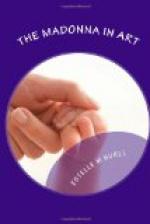Cimabue’s Madonna still hangs in Santa Maria Novella, over the altar of the Ruccellai chapel, and thither many a pilgrim takes his way to honor the memory of the father of modern painting. The throne is a sort of carved armchair, very simple in form, but richly overlaid with gold; the surrounding background is filled with adoring angels. Here sits the Madonna, in stiff solemnity, holding her child on her lap. If we find it hard to admire her beauty, we must note the superiority of the picture to its predecessors.
For the enthroned Madonna in a really attractive and beautiful form, we must pass at once to the period of full art development. In the interval, many variations upon the theme have been invented. The throne may be of any size, shape, or material; the composition may consist of any number of figures. The Madonna, seated or standing, is now the centre of an assembly of personages symmetrically grouped about her. There is little or no unity of action among them; each one is an independent figure. The guard of honor may be composed of saints, as in Montagna’s Madonna, of the Brera, Milan; or again it is a company of angels, as in the Berlin Madonna, attributed to Botticelli, similar to which is the picture by Ghirlandajo in the Uffizi Gallery. Where saints are represented, each one is marked by some special emblem, the identification of which makes, in itself, an interesting study. St. Peter’s key, St. Paul’s sword, St. Catherine’s wheel, and St. Barbara’s tower soon become familiar symbols to those fond of this kind of lore.
Among the idealized presences about the Virgin’s throne may sometimes be seen the prosaic figure of the donor, whose munificence has made the picture possible. This is well illustrated in the famous Madonna of Victory in the Louvre, painted in commemoration of the Battle of Fornovo, where Mantegna represents Francesco Gonzaga, commander of the Venetian forces, kneeling at the Virgin’s feet.
A charming feature in many enthroned Madonnas is the group of cherubs below,—one, two, or the mystic three. They are not the exclusive possession of any single school of art; Bartolommeo and Andrea del Sarto of the Florentines, Francia of the Bolognese, and Bellini and Cima of the Venetians were particularly partial to them. The treatment in Northern Italy gives them a more definite purpose in the composition than does that of Florence, for here they are always musicians, playing on all sorts of instruments,—the violin, the mandolin, or the pipe.
Bartolommeo was specially successful in the subject of the enthroned Madonna, having fine gifts of composition united with profound religious earnestness. The great picture in the Pitti gallery at Florence may serve as a typical example. Andrea del Sarto’s chef-d’oeuvre—the Madonna di San Francesco (Uffizi)—may also be assigned to this class, although the arrangement is entirely novel. The Virgin, holding the babe in her arms, stands on a sort of pedestal, carved at the corners with a design of harpies, from which the picture is often known as the Madonna of the Harpies. The pedestal throne is also seen in two of Correggio’s Dresden pictures, but here the Virgin is seated, with the child on her lap. An exceedingly simple throne Madonna is that of Luini, in the Brera at Milan, where the Virgin sits on a plain coping not at all high.




